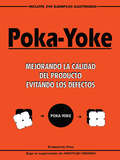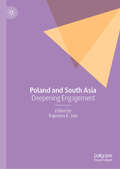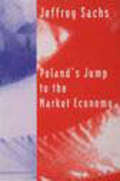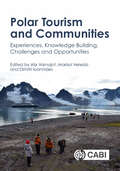- Table View
- List View
Poka-yoke (Spanish): Mejorando la Calidad del Producto Evitando los Defectos
by H. HiranoMuchas cosas pueden ir mal en un entorno de trabajo. Cada dia hay oportunidades para cometer errores que resultaran en defectos. Los defectos son despilfarro y, si no se descubren, frustran las espectativas del cliente sobre la calidad. Detras del poka-yoke esta la conviccion de que no es aceptable producir incluso un pequeno numero de articulos defectuosos. Durante mas de 200 visitas a fbricas Japonesas, Productivity ha presenciado el impacto de simples mecanismos poka-yoke instalados por los propios trabajadores para evitar la ocurrencia de defectos. En este libro, 240 ejemplos poka-yoke despertaran su imaginacion para planificar e implantar sistemas de prevencion de errores.Contenido:Errores de proceso Errores de montaje Errores de ensamble Inclusion de items erroneos Errores de insercion Omisiones en montaje Omisiones en proceso Errores de medicion Errores dimensionales Omision de operaciones Errores de operacion Errores de pegado Errores de inspeccion Errores de cableado Errores de pintura Errores de impresion Desalineamientos Errores en preparacion de mquinas Errores de embalaje Desajuste de plantillas y utiles Errores de lavado Problemas miscelaneos
Poke The Box: When Was the Last Time You Did Something for the First Time?
by Seth GodinFinally available in bookstores, Seth Godin's spirited call to action that demands that you stop waiting for a road map and start drawing one insteadYour reputation in the world is defined by what you instigate, how you provoke, and what you learn from the events you cause.<P><P> In a world filled with change, that's what matters--your ability to create and learn from change. You don't need more time. You merely need to decide.You don't need approval, or reassurance or even permission.You merely need to decide. Poke the Box is a call to action about the initiative you're taking--in your job or in your life. Seth Godin will help you to get started and contribute more, risk more, and face the possibility of failure without dread. Godin knows that we ought to be much more concerned about mediocrity than failure. "If you can't fail," Seth writes, "it doesn't count." Poke the Box just may be the kick in the pants you need to shake up your life.
Pokemon: Gotta Catch 'Em All
by Susan FournierPokemon, the colloquial name given to a collection of 150 fantastic, animal-inspired creatures with organic powers and the capacity to evolve, are the stars of video games, trading card games, and TV cartoons. Conceived in Japan in 1996, Pokemon quickly became that nation's favorite toy phenomenon, and attracted the attention of Nintendo of America, which, in February 1998, purchased all intellectual rights to everything bearing the Pokemon name outside Asia. Launched in September 1998, Pokemon quickly took the United States by storm, single-handedly resuscitating Nintendo's lagging video game sales and earning stature as one of the top three licensing success stories by year-end 1999 (on worldwide sales of $7 billion and U.S. sales of $1.2 billion). How did management at Nintendo and licensing partner 4Kids Entertainment accomplish this and, perhaps more importantly, can they sustain (and perhaps grow) Pokemon's success over time? Is Pokemon just a passing fad to be "milked," or can it be managed as a sustainable brand franchise? Was Pokemon's success simply a fluke, an unpredictable function of mere good fortune, or is sound brand strategy and planning the cause? Includes color exhibits.
The Pokemon Company: Evolving into an Everlasting Brand
by Masaki Nomura Tomomichi AmanoSuper Bowl 50, the fiftieth annual championship game of the American National Football League played in February 2016, featured 52 commercials, and brands spent more than six million dollars each for a 30-second commercial slot. Surprisingly, the commercial that garnered the most popularity on YouTube was not one of the regular advertisers. It was an entertainment brand best known for its video games and characters-Pok mon. It reflected twenty years of faithful corporate efforts that had protected and nurtured the Pok mon brand ever since its debut on February 27, 1996, in the form of a video game for handheld devices. Even on this commemorable day, however, Tsunekazu Ishihara, president of The Pok mon Company, was asking his staff and himself a familiar question: "Is that really in the best interest of Pok mon?" This question came out of a sense of urgency that motivated him and his vision for the Pok mon brand, having seen firsthand how rapid growth and record-breaking sales had led countless other games to quick obsolescence. In fact, Pok mon itself had once run a real risk of becoming nothing more than a fad. As he looked to the future, Ishihara pondered threats and opportunities, such as the intensifying competition due to the accelerating development cycle of video games and the maturation of emerging economies. He asked himself how he could make the Pok mon brand one that could endure and continue to grow over the next 25 years.
The Poker Face of Wall Street
by Aaron BrownWall Street is where poker and modern finance?and the theory behind these "games"?clash head on. In both worlds, real risk means real money is made or lost in a heart beat, and neither camp is always rational with the risk it takes. As a result, business and financial professionals who want to use poker insights to improve their job performance will find this entertaining book a "must read." So will poker players searching for an edge in applying the insights of risk-takers on Wall Street.
Polanco: A Fashionable Opportunity
by Arthur I Segel Ben CreoRoberto Charvel is a young MBA graduate making his first personal real estate investment in his native Mexico City. Charvel is planning to purchase and renovate a nine unit apartment building. Is the market good? Should he sell or lease the units? How should he handle other issues like the architectural designs, the construction process, and the legal process? How should he balance all the competing demands on his time? This case serves as an introduction to the multifamily property type.
Poland and South Asia: Deepening Engagement
by Rajendra K. JainThis book explores the political, economic, defence, and cultural relations of Poland with South Asia—Afghanistan, Bangladesh, Bhutan, India, Myanmar, Nepal, Pakistan, and Sri Lanka—since the late 1940s to the present. It examines how Polish preoccupation with gaining admission to NATO and the European Union led South Asia to fade into the margins of Polish foreign policy. It discusses key narratives and perceptions of South Asia in the Polish media and thinktanks, features of the South Asian diaspora in Poland, and assesses future prospects of Warsaw’s deepening political and economic engagement with the region. The pioneering book will be essential reading for students and scholars of Central/East European studies, International Relations, Indian foreign policy, Polish-Asian politics and foreign policy.
Poland and the Eurozone: How Accession Countries Catch Up and Integrate in the European Union (Studies in Economic Transition)
by Jens HölscherPoland is one of Europe's economic out-performers. The country's history and geography encourage it to be in favour of deeper European integration. This book aims to contribute to discussions on the future shape of EMU and the next steps ahead.
Poland at a Crossroads
by Christian H.M. Ketels Haviland Sheldahl-Thomason Laura Alfaro Marcin PiatkowskiCase
Poland From Partitions to EU Accession: A Modern Economic History, 1772–2004
by Piotr KoryśThis book surveys Poland’s move from being a post-feudal, backward, peripheral country to being a modern, capitalist, European state: from the partition of the commonwealth of Poland and Lithuania to the abolishment of ‘second serfdom’; late industrialization to state socialism; post-partition fragmentation to post-Second World War westward dislocation; and from the ‘Solidarność’ movement to accession into the European Union.Could Poland really be considered an ‘underdeveloped’ nation throughout the last 200 years? What factors contributed to its ‘backwardness’? Has Poland yet managed to catch up with the West? This book, the first overview of the modern economic history of Poland to be published in English, addresses these and many other questions crucial for developing our understanding of the economic history of modern Central-Eastern Europe. The economic development of Poland is analyzed through data and statistics, as well as through analysis of the ideas that paved the way for the politics of economic and social modernization.
Poland in the Single Market: Politics, economics, the euro (Europa Perspectives on the EU Single Market)
by Anna Visvizi, Anna Matysek-Jędrych and Katarzyna Mroczek-DąbrowskaBy all accounts, the case of Poland and its segue to market economy and democracy is a success story: 30 years of uninterrupted growth and development, infrastructure expansion, and modernization of the economy and society. Epochal changes have unfolded in a timespan of merely three decades. Change has taken place so fast that children born in late 1980s and onwards cannot remember what life in Poland under communism was like and cannot relate to it. Also, many elderly people, easy victims of romanticizing their own youth, tend to forget. As a result, the uniqueness of Polish transition and transformation, the boldness and efficiency of reforms, and the success that Polish society mastered together, tend to be undermined today both domestically and internationally. Poland has now been a member of the EU for more than 15 years. During that time, Poland’s image on the EU scene evolved from newcomer, through ‘model child’, champion of growth, to – in some respects – a maverick. This volume’s objective is to remind society, old and young, researchers, scholars and practitioners, that Poland’s success is an outcome of well-thought out and bold structural reforms implemented in a swift and timely manner, of society’s support for these reforms, and of third actors’ benign assistance. Looking back on the 30 years since the collapse of communism, and at the over 15 years of EU membership, this book offers an interdisciplinary, comprehensive and critical insight into factors and processes that have led to today’s Poland.
Poland Spring Bottling Corp.
by Benson P. Shapiro Jeffrey J. ShermanPoland Spring is a small domestic bottler of mineral water trying to compete in a rapidly expanding market against Perrier, the dominant brand, and 20 other foreign and domestic waters. Company management must decide how to position and promote its product with limited resources. An excellent case to force decision making on consumer marketing strategy.
Poland's A2 Motorway
by Benjamin C. Esty Michael KaneAutostrada Wielkopolska S.A. (AWSA) is a consortium of 18 firms that won a concession to build and operate Poland's first private toll road. In June 2000, AWSA's chief financial officer, Wojciech Gebicki, is preparing for a meeting with the projects' lead bankers to discuss concerns they have regarding the traffic forecasts and revenue projections. Based on their concerns, the bankers are asking the sponsors to inject an additional e60 to e90 million of equity into the deal, a sizeable increase given the projects' total cost of e934 million and the sponsor's current equity commitment of e235 million. This request presents a serious problem for Gebicki (AWSA) because the concession is scheduled to expire in six weeks if financing has not closed and because he has very few options available to address the problem. This case describes the deal structure and invites students to accept or dispute Gebicki's view that the major risks have been identified, assessed, and mitigated in such a way that the senior lenders are adequately protected without further equity support.
Poland's Jump to the Market Economy (Lionel Robbins Lectures)
by Jeffrey Sachsan insider's analysis of the political events and economic strategy behind the country's swift transition to capitalism and democracyIn Poland's jump to the Market Economy, Jeffrey Sachs provides an insider's analysis of the political events and economic strategy behind the country's swift transition to capitalism and democracy. The greatest challenges to economic reform, Sachs points out, have been primarily political in nature, rather than social or even economic. Sachs reviews Poland's striking progress since the start of the economic reforms three years ago, which he helped to design. He discusses the gains - more than half of employment and GDP is now in the private sector, exports to Western Europe have more than doubled, and economic growth and confidence are returning - as well as the serious problems that remain - high unemployment, a chronic fiscal deficit, the slow pace of privatization of large industrial enterprises, and the fragility of multiparty coalition governments.Sachs points out that leadership is crucial to economic reform in a newly democratic setting, as is the West's timely economic assistance. In Poland's case, the Zloty Stabilization Fund and the two-stage debt cancellation have been essential to keeping the reform program on track. Poland's example has had a powerful impact on reforms throughout the region, including the former Soviet Union, and has done much to dispel the fear that the citizens themselves, allegedly made lazy by decades of socialism, would reject the competitive rigors of a market economy. Overall, Sachs remains firmly convinced of the potential for successful economic reforms in Poland and the rest of the region.
Poland's Jump to the Market Economy
by Jeffrey SachsIn Poland's jump to the Market Economy, Jeffrey Sachs provides an insider's analysis of the political events and economic strategy behind the country's swift transition to capitalism and democracy. The greatest challenges to economic reform, Sachs points out, have been primarily political in nature, rather than social or even economic.Sachs reviews Poland's striking progress since the start of the economic reforms three years ago, which he helped to design. He discusses the gains - more than half of employment and GDP is now in the private sector, exports to Western Europe have more than doubled, and economic growth and confidence are returning - as well as the serious problems that remain - high unemployment, a chronic fiscal deficit, the slow pace of privatization of large industrial enterprises, and the fragility of multiparty coalition governments.Sachs points out that leadership is crucial to economic reform in a newly democratic setting, as is the West's timely economic assistance. In Poland's case, the Zloty Stabilization Fund and the two-stage debt cancellation have been essential to keeping the reform program on track.Poland's example has had a powerful impact on reforms throughout the region, including the former Soviet Union, and has done much to dispel the fear that the citizens themselves, allegedly made lazy by decades of socialism, would reject the competitive rigors of a market economy. Overall, Sachs remains firmly convinced of the potential for successful economic reforms. in Poland and the rest of the region.Jeffrey Sachs is Galen L. Stone Professor of International Trade at Harvard University, and has been an economic advisor to more than a dozen countries around the world, including Bolivia, Mongolia, Poland, and Russia.
Polar Bear Pirates and Their Quest to Engage the Sleepwalkers
by Adrian Webster Phil WilliamsConquer complacency and transform your team into a happy, winning crew.Polar Bear Pirates are highly focused, successful characters, they can't help but motivate everyone around them and just like you; they love to have some fun.In their latest quest, they take on the Sleepwalkers, the workplace zombies who are with you in body but never take a step beyond the ordinary because their minds have drifted into sleep mode. Going through the motions, thinking the same old stuff and delivering the same results, they stand out like beacons of disappointment.Sleepwalkers can be found orbiting Planet Complacency. This place is in the arch enemy of success! It is a huge planet, more powerful than the inhospitable Rock Bottom, it appears to be a comfortable, safe and popular place to be. Yet this silent assassin is responsible for snuffing out millions of dreams and kidnapping untold potential.Stepping Beyond OrdinaryThe Polar Bear Pirates' mission is to re-awaken dormant talent and release untapped potential. Join them and meet a cast of amazing characters, from Neg Ferrets and Bloaters, to Amps and Vamps. One thing's for sure, you'll come out the other side inspired and ready to get the best out of your team and the people around you.Polar Bear Pirates shows you how to motivate everyday people to deliver extraordinary results.
Polar Sports, Inc.
by W. Carl Kester Wei WangPolar Sports, Inc. is a fashion skiwear manufacturing company in Littleton, Colorado. The company has a unique design for skiwear using a special synthetic material that improves insulation and durability. The ski apparel industry is highly competitive and the best way for companies to gain market share is by developing new fabrics and using innovative patterns. The firm generates over 80% of sales between September and January and relies on seasonal production to respond promptly to customer orders. During those months, the plant must rapidly increase production by hiring and training additional workers, often paying them overtime. The vice president of operations is concerned about the costs associated with seasonal production and presents a proposal to switch to level production. The change can reduce costs and improve efficiency but can also affect other aspects of company finance. Students must analyze potential cost savings and understand the financial risks involved before making a final recommendation. This case can be used in first-year MBA-level courses in finance or in advanced undergraduate finance courses.
Polar Tourism
by John Snyder Bernard StonehouseTourism throughout the world raises environmental issues that are often concerned with conflicting rights and responsibilities: the inherent right of mankind to travel, the no-less inherent right of indigenous people to guard their environmental heritage, and the responsibility of governments - local, national or (in the unique case of Antarctica) international - to protect environments over which they exercise stewardship. Additionally, the presence of international commercial enterprises, especially marine and other mass transport modes, represent unique governance challenges. This book deals mainly with environmental issues and the management implications arising from polar tourism, one of the fastest-growing sectors of world tourism. However, many of the issues discussed here arise no less urgently in temperate and tropical wilderness areas, and indeed in any region where sensitive environments are subjected to mass tourism. The principles and guidelines discussed here are of interest and practical use in tourism studies generally.
Polar Tourism and Communities: Experiences, Knowledge Building, Challenges and Opportunities
by Alix Varnajot, Marisol Vereda & Dimitri IoannidesPrior to the outbreak of the coronavirus pandemic in 2020, the Arctic and Antarctic regions were experiencing significant growth in tourist arrivals. In the aftermath of this global crisis, the tourism industry has rebounded and the number of tourists visiting the polar regions is expected to keep growing significantly in the coming years. Remote regions are increasingly accessible as tourism actors develop technologies, diversify activities and itineraries, and climate change worsens. In the Arctic, tourism now takes place year-round through various modalities, ranging from exclusive icebreaker expeditions to the North Pole to mass tourism practices in several destinations such as Rovaniemi, Reykjavik, Longyearbyen or Skagway, wherein tourism not only brings opportunities, but also new challenges to local communities. Meanwhile, gateway cities to Antarctica such as Ushuaia and its inhabitants are set to recover from the severe adverse effects due to the virtual standstill of tourism in the region. This book fills the gap in literature on polar tourism and communities. Through several examples encompassing the Arctic and Antarctica, various chapters examine how both the tourism industry and various communities impact and influence each other from economic, sociocultural, political and environmental perspectives. The contents provide a general perspective regarding polar tourism and chapters focusing on challenges and/or experiences of the communities that are related to tourism in the polar regions and delivers: · Exploration of the complex interactions between polar tourism and local communities · Coverage of a broad range of topics including safety, environmental care, increase in the number of visitors, and the pursuit of new experiences at the farthest extremes of the world. Overall, this book provides a unique and timely analysis of the complex interactions between polar tourism and local communities and could be of interest to advanced-level students and researchers in tourism studies and polar geographies.
Polarization Theory of Nuclear Reactions
by Qing-Biao ShenThis book provides the reader with a modern and comprehensive overview of nuclear polarization theory. The understanding of polarization phenomena greatly enriches data obtained from scattering and nuclear reactions by providing information on the interaction that can change spin orientation as well as important verification data for the study of nuclear structures and reaction mechanisms. The author methodically derives the polarization theory of nuclear reactions for various types of elastic scattering and two-body direct reactions between particles of different spin and unpolarized target nuclei with arbitrary spin, as well as the reactions between two polarized light particles and the polarization theory for photon beams. In addition, the polarization theories of relativistic nuclear reactions are rigorously covered in great scope and detail. A chapter on polarized particle transport theory presents the Monte-Carlo method for describing the transport of polarized particles and formalizes the polarized particle transport equation. Here, the author also illustrates a novel and concrete scheme for establishing a polarization nuclear database. Nuclear polarization is important not only for microscopic nuclear structure and reaction studies but also for nuclear engineering, applied nuclear physics, and medical physics. With the development of radioactive beam facilities and, on the theoretical side, the development of consistent microscopic nuclear reaction and structure theories, this book on the polarization theory of nuclear reactions serves as a timely source of reference for students and researchers alike.
Polarized America: The Dance of Ideology and Unequal Riches
by Nolan Mccarty Keith T. Poole Howard RosenthalChoice Outstanding Academic Title, 2007. The idea of America as politically polarized--that there is an unbridgeable divide between right and left, red and blue states--has become a cliche. What commentators miss, however, is that increasing polarization in recent decades has been closely accompanied by fundamental social and economic changes--most notably, a parallel rise in income inequality. In Polarized America, Nolan McCarty, Keith Poole, and Howard Rosenthal examine the relationships of polarization, wealth disparity, immigration, and other forces, characterizing it as a dance of give and take and back and forth causality. Using NOMINATE (a quantitative procedure that, like interest group ratings, scores politicians on the basis of their roll call voting records) to measure polarization in Congress and public opinion, census data and Federal Election Commission finance records to measure polarization among the public, the authors find that polarization and income inequality fell in tandem from 1913 to 1957 and rose together dramatically from 1977 on; they trace a parallel rise in immigration beginning in the 1970s. They show that Republicans have moved right, away from redistributive policies that would reduce income inequality. Immigration, meanwhile, has facilitated the move to the right: non-citizens, a larger share of the population and disproportionately poor, cannot vote; thus there is less political pressure from the bottom for redistribution than there is from the top against it. In "the choreography of American politics" inequality feeds directly into political polarization, and polarization in turn creates policies that further increase inequality.
Polarized America: The Dance of Ideology and Unequal Riches
by Keith T. Poole Nolan Mccarty Howard RosenthalThe idea of America as politically polarized -- that there is an unbridgeable divide between right and left, red and blue states -- has become a cliché. What commentators miss, however, is that increasing polarization has been closely accompanied by fundamental social and economic changes -- most notably, a parallel rise in income inequality. In this second edition of Polarized America, Nolan McCarty, Keith Poole, and Howard Rosenthal use the latest data to examine the relationships of polarization, wealth disparity, immigration, and other forces. They find that inequality feeds directly into political polarization, and polarization in turn creates policies that further increase inequality. Paul Krugman called the first edition of Polarized America "Important.... Essential reading for anyone who wants to understand what's happening to America." The second edition has been thoroughly brought up to date. All statistical analyses, tables, and figures have been updated with data that run through 2012 or 2014, and the text has been revised to reflect the latest evidence. The chapter on campaign finance has been completely rewritten (with Adam Bonica as coauthor); the analysis shows that with so much "soft" money coming from very wealthy ideological extremists, there is even greater campaign contribution inequality than income inequality.
Polarized America, second edition: The Dance of Ideology and Unequal Riches (Walras-Pareto Lectures)
by Nolan McCarty Keith T. Poole Howard RosenthalUpdated analysis of how the increasing polarization of American politics has been accompanied and accelerated by greater income inequality.The idea of America as politically polarized—that there is an unbridgeable divide between right and left, red and blue states—has become a cliché. What commentators miss, however, is that increasing polarization has been closely accompanied by fundamental social and economic changes—most notably, a parallel rise in income inequality. In this second edition of Polarized America, Nolan McCarty, Keith Poole, and Howard Rosenthal use the latest data to examine the relationships of polarization, wealth disparity, immigration, and other forces. They find that inequality feeds directly into political polarization, and polarization in turn creates policies that further increase inequality. Paul Krugman called the first edition of Polarized America “Important.... Essential reading for anyone who wants to understand what's happening to America.” The second edition has been thoroughly brought up to date. All statistical analyses, tables, and figures have been updated with data that run through 2012 or 2014, and the text has been revised to reflect the latest evidence. The chapter on campaign finance has been completely rewritten (with Adam Bonica as coauthor); the analysis shows that with so much “soft” money coming from very wealthy ideological extremists, there is even greater campaign contribution inequality than income inequality.
Polaroid: Entering Digital Imaging
by John Lafkas Mary Tripsas Elizabeth Johnson Giovanni GavettiFocuses on Polaroid's attempt to respond to the changes to its competitive environment that are entailed by the rise of digital imaging.
Polaroid Corp.: European Distribution System
by Janice H. Hammond Afroze MohammedDescribes distribution operations in Polaroid Europe. In the late 1980s, Polaroid senior management in the United States proposed moving from a system of 12 decentralized warehouses to a centralized distribution system in which all inventory for European retailers would be held in Polaroid's Dutch distribution center. Most subsidiary general managers opposed the proposal, as did Polaroid's European marketing organization. Describes several distribution alternatives Polaroid considered in 1990 including: 1) direct distribution to retailers through Europe from the Dutch distribution center, 2) hiring a third-party logistics organization to take over all of Polaroid's European distribution activities, and 3) establishing regional satellite distribution centers. Provides an overview of changes in the European retailing and distribution industries at the beginning of the 1990s, with a specific focus on the diverse service expectations of retailers in different European countries and of different retail segments.
















